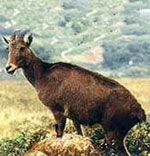The Nilgiri Biosphere Reserve (NBR), the first of the fourteen biosphere reserves of India, established in September 1986, embraces the sanctuary complex of Wyanad, Nagarhole, Bandipur and Mudumalai, the entire forested hill slopes of Nilambur, the Upper Nilgiri plateau, Silent Valley and the Siruvani hills. The total area of the biosphere reserve is around 5520 sq.km, of which 1240 sq.km are the core zone, 3239 sq km the manipulation zone (forestry) and it has around 335 sq.km the manipulation zone (agriculture) and 706 sq.km as restoration zone.
The NBR possesses different habitat types, unspoiled areas of natural vegetation types with several dry scrub, dry and moist deciduous, semi evergreen and wet evergreen forests, evergreen sholas, grass lands and swamps. The NBR includes the largest known population of two endangered animal species, namely the Nilgiri Tahr and the Lion - tailed macaque and the largest South Indian population of elephant, tiger, gaur, sambar and chital as well as a good number of endemic and endangered plants. The NBR is the habitat of a number of tribal groups remarkable for their traditional modes of harmonious use of the environment.

Niligiri Biosphere is one of the world's biodiversity hotspots and provides habitat for the probably largest South Indian populations of tigers, elephants and other large mammals. The Nilgiri Biosphere Reserve is very rich in plant diversity consisting of 3,300 species of flowering plants and 175 species of orchids. The fauna of the NBR includes over 100 species of mammals, 350 species of birds, 80 species of reptiles and amphibians, 300 species of butterflies and innumerable invertebrates. 39 species of fish, 31 amphibians and 60 species of reptiles endemic to the Western Ghats also occur in the NBR.
The objectives of Nilgiri Biosphere Reserve
» To conserve insitu genetic diversity of species
» To restore degraded ecosystems to their natural conditions
» To provide baseline data for ecological and environmental research and education
» To function as an alternate model for sustainable development
Flora of Nilgiri Biosphere

Nilgiri Biosphere Reserve harbours 3.187 species of flowering plants. About 80% of florwering plants recorded from Western Ghats occur in NBR. It has a rich floristic diversity and is represented by the highest number of species in all dominat families of India. NBR harbours 112 endemic species. There are two genera that are endemic to NBR namely Baeolepis Decne. Ex Moq. (Periplocaceae) and Silentvalleya V. J. Nair et al. (poaceae).
This NBR supports a good number of wild relatives of cultivated species. They include species of Ammomum, Alpinia, Cinnamomum, Coffea, Curcuma, Garcinia, Myristica, Zingiber and Piper. Of 185 taxa that are recorded as threatened species from Southern Western Ghats 53 taxa are found in Nilgiris.
Endemic Plants of NBR
